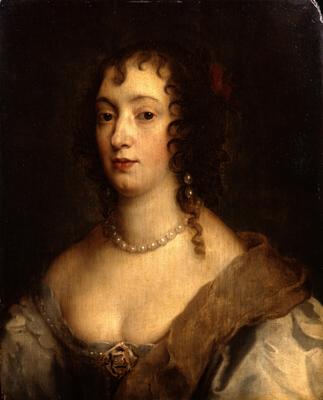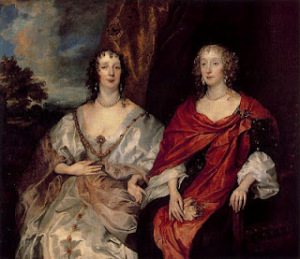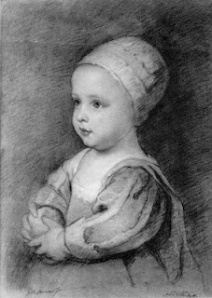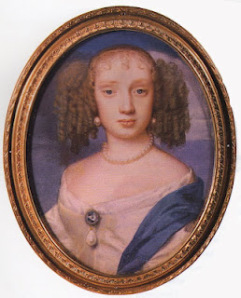

While three St John sons famously gave their lives fighting for the Royalist cause during the English Civil Wars, another member of the family – a woman – performed an equally brave act of duty and devotion.
Anne Villiers was the daughter of Sir Edward Villiers and Barbara St John, the 5th daughter of Sir John St John and Lucy Hungerford. The date of her birth appears unconfirmed as does her name, occasionally mentioned as Elizabeth, but the part she played in history is not up for debate.
Anne married Robert Douglas, Lord Dalkeith, 8th Earl of Morton, in around 1627. Little is written about their married life. At least three children survived to adulthood. Their son and heir, William 9th Earl of Morton, Lady Anne Douglas, who married the Earl of Marischall and Lady Mary Douglas who married Sir Donald Macdonald. Lady Anne is mentioned in her grandmother’s will along with her more notorious cousin, Charles II’s mistress Barbara, Duchess of Cleveland
Anne, Lady Dalkeith was a Lady in Waiting to Charles I’s French born Queen, Henrietta Maria and is pictured with Anne Kirke in a portrait by Anthony van Dyck painted in the late 1630s.

In 1644 England was in the grip of war. Royalist York was under siege, Lincolnshire and Manchester lost and the Royal court headquartered at Oxford was under threat.
The heavily pregnant Queen left Oxford to seek refuge in her homeland. Forced to halt her journey at Exeter, the Queen came under the protection of Sir John Berkeley, Governor of the city. The Queen’s health gave cause for concern and the baby daughter she gave birth to on June 16, 1644 was small and delicate.
Just two weeks after giving birth Henrietta was forced to continue her journey and placed her baby daughter in the care of Anne, Lady Dalkeith. She could hardly have chosen a better guardian for the little Princess.
The child’s first few months were blighted by ill health and uncertainty. By the autumn of 1645 Exeter was surrounded by Parliamentarian troops under the leadership of Sir Thomas Fairfax and Sir William Waller.

The Royal garrison held out for more than six months until, at the point of starvation, Sir John Berkeley was forced to surrender.
Berkeley escorted the small royal entourage to Salisbury where Anne informed Fairfax of the arrangements she had made with the King.
“I have prevailed with Mr Ashburnham to acquaint you that I have His Majesty’s allowance to remain, with the Princess, for some time about London, in any of His Majesty’s houses. I have judged Richmond the fittest. This bearer will inform you of those particulars concerning the settlement of the Princess in that place, wherein I conceive your assistance and recommendation to the Parliament to be necessary, which His Majesty will acknowledge as a service, and I as an obligation to Sir, your humble servant. A. Dalkeith,” she wrote.
But Parliament now called the shots and instructed Anne that she should take the child not to Richmond but to Oatlands, a Royal house near Weybridge, Surrey. The allowance promised for the Princess’ support was withheld and Lady Dalkeith paid all the household bills out of her own pocket.
Next came the order that Anne should deliver the child to St James’ Palace, where she would join her brother and sister, the young Duke of Gloucester and the Princess Elizabeth, in the charge of Lady Northumberland. She would then be dismissed from her post.

But Anne was having none of this. Although she had no objection to taking orders from the Lord and Lady Northumberland, she had made a promise to her King and there was no way she was going to give up the young Princess.
Anne wrote to the Speakers of both Houses of Parliament asking for the allowance as promised and her intention to remain with the child. She waited a month for a reply, before taking events into her own hands.
Anne hatched a daring plan that would test her courage and her physical strength to the limit. She would reunite the child with her mother – in France.
On the night of July 24, 1646 Anne, the child and two trusted servants left Oatlands under cover of darkness. Anne disguising herself as a beggar woman, dressed the three year old Princess in a ragged suit of boy’s clothes, and with the child on her back, walked to Dover, a distance of approximately 95 miles.
Apparently the little Princess further compromised their perilous situation by regularly announcing that she was not ‘Pierre,’ the name given her for the flight, but ‘the Princess.’
Anne wrote en route to the staff at Oatlands, informing them she had ‘removed her Highness to a better air’ and pleading that they ‘conceal her being gone as long as you can.’
The faithful Sir John Berkeley followed at a distance until, arriving at Dover, they boarded a French boat bound for Calais. Landing on French soil, Anne wrote to the Queen who sent a carriage to convey them to Saint Germain.
It is no exaggeration to say the journey nearly killed Anne. Having handed over the young Princess to her mother, the Queen, Anne collapsed and was seriously ill for several weeks. But Anne’s heroic feat did not go unrecognised and she was much feted during her lifetime.
Anne remained with her Royal charge until the death of her husband Robert Douglas, Lord Dalkeith and 8th Earl of Morton and in 1651 she returned to England where it was said her children required her presence.
Anne died in 1654 following a bout of fever.